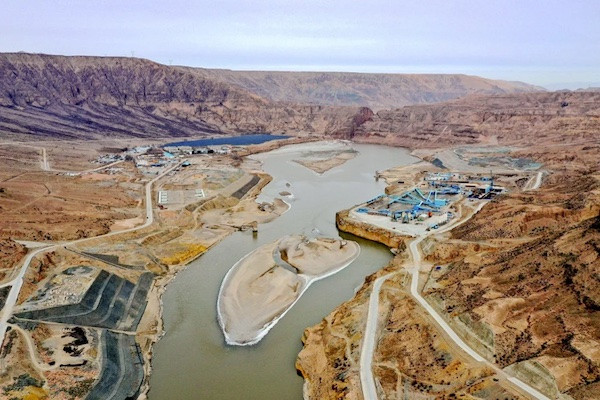Without using workers, China builds hydroelectric dams with 3D printing and robotics technology
The 180m high Yangqu hydroelectric project will be built according to design slices without using any human labor. All the machines involved in the project such as excavators, trucks, bulldozers, pavers or rollers are controlled by AI, in the same process used in 3D printing.

The hydroelectric dam, scheduled to be completed in 2024, is capable of generating nearly 5 billion kilowatt-hours of electricity per year from the upper Yellow River to supply Henan province, the cradle of Chinese civilization, and also the cradle of Chinese civilization. home to 100 million people.
Power from the plant will pass through a 1,500-kilometer high-voltage line, built specifically for the transmission of green energy.
Hydroelectric dam construction and 3D printing are essentially the same
According to an article by Liu Tianyun, scientist and project leader, published in the journal Science and Technology of Tsinghua University, hydroelectric dam construction and 3D printing are “in essence identical”.
After years of experimentation, 3D printing technology is now advanced enough for mass application for large-scale infrastructure construction and will “free people from heavy, repetitive and dangerous jobs.” “, said Mr. Liu.
Mr. Liu is a research expert affiliated with a key state laboratory at Tsinghua University for hydraulics and engineering. His team came up with the idea of ”printing” large-scale construction projects 10 years ago.
They came up with the idea that the whole construction site could become one giant printer, with a large number of automated machines in different parts, working continuously at the same time.
Initially, 3D printing technology was developed to produce parts from precious materials in order to save raw materials and generate less waste than traditional cutting and grinding.
Since then, a number of architects have begun to apply the technology to buildings, although projects to date have remained on a small scale. The world’s first office building, the headquarters of the Dubai Future Foundation, is only 6m high.
Combined with the power of AI and automation
Meanwhile, Chinese civil engineers are no stranger to AI, which was used to build Baihetan, the world’s second-largest dam, in just four years. Even so, until now AI has mainly played a coordinating role in projects.
Testing this technology in previous construction projects has shown that intelligent machines can do the job better than humans, “especially in some harsh and dangerous environmental conditions”, said Liu. and colleagues commented.
Mr. Liu did not mention the construction progress of the Yangqu Dam, but according to Chinese state media, the project was started late last year in Hainan, in the Tibet Autonomous Region, Qing province. Sea.
After the computer model of the dam is divided into several layers, the AI at the operations center assigns a team of robots to automatically complete the construction of each layer, the journal article also said.
Unmanned excavators are capable of identifying and scooping materials from a dump onto self-propelled trucks, some of which are electric.
According to the AI-calculated route, the trucks will deliver the right materials to the right location, at the right time, and are positioned by automated bulldozers and pavers to build the structural layer of the dam.
Automatic, sensor-equipped rollers press so that the layers become firm. Executive AI uses these sensors to monitor construction quality, through analysis of ground vibrations and other data.
One of the breakthroughs of AI technology includes reinforcement learning, which allows machines to recognize nearly all objects on the construction site, handle uncertainties in a constantly changing environment as well as flexibly perform different tasks.
They also don’t make mistakes like humans. Liu said truckers often deliver materials to the wrong location. In addition, the strong vibration also makes the roller operator unable to maintain a completely straight line. And most workers can’t read engineering design papers correctly, he added.
The biggest advantage of the machines, the researchers say, is that they are capable of operating 24 hours a day in hazardous environments without the headaches of hypoxia or exhaustion.
However, not all work during dam construction will be handled by machines. Some complex tasks such as mining backfill from nearby mountains will still be done manually.
Liu’s team believes the technology could also be used in other infrastructure projects such as airports or roads. “AI based on knowledge, information and data is a new tool that will shape our future.”
A civil engineering scientist in Nanjing said that 3D printing technology has some limitations, but it will still be used more in the future.
“It cannot print a structure composed of many different materials, such as reinforced concrete made of steel and cement,” this expert said.
Vinh Ngo (according to SCMP)
at Blogtuan.info – Source: vietnamnet.vn – Read the original article here



